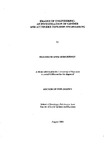IMAGES OF ENGINEERING: AN INVESTIGATION OF GENDER AND ATTITUDES TOWARDS ENGINEERING
| dc.contributor.author | HODGKINSON, ELIZABETH ANNE | |
| dc.contributor.other | School of Society and Culture | en_US |
| dc.date.accessioned | 2013-09-10T11:47:03Z | |
| dc.date.available | 2013-09-10T11:47:03Z | |
| dc.date.issued | 2003 | |
| dc.identifier | NOT AVAILABLE | en_US |
| dc.identifier.uri | http://hdl.handle.net/10026.1/1637 | |
| dc.description.abstract |
The research presented in this thesis used a mixed method approach to investigate the attitudes of sixth-form students in two British cities, towards engineering as a career, with the aim of finding out which factors encourage or discourage young people from becoming engineers, and whether these differ for males and females. The study can be set in the context of the declining popularity of engineering as a career choice for males and the continuing under-representation of females, for whom engineering is a non-traditional career choice. The principal research hypothesis was that negative images of engineering discourage girls and many boys from considering it as a career, with a particular focus on whether engineering and the school subjects closely related to it, are considered to be more appropriate for males than for females. The study was informed by a social science realist framework, in which 'attitudes' were not accorded the status of fixed attributes of individuals, but were understood as indicators of the underiying social construction of meanings and ideologies. It was found that the students in this study had made subject and career choices that conform to traditional gender patterns. The intention to pursue engineering as a career was highly dependent upon sex, with males being almost seven times as likely to consider it as a career than females. Although the students did not consciously subscribe to sexstereotyped views of subjects and occupations, these were inadvertently reproduced through the students' constructions of meaning. Initiatives to increase female participation in engineering have been based on overly voluntaristic conceptions of choice, whereby women are seen to straightforwardly reject the masculine image of engineering. However, this research suggests that understandings of both gender and engineering can be better understood as less intentionally constituted in 'discourses', which reinforce the association between engineering and specific forms of masculine identity, to exclude most women and many men. | en_US |
| dc.language.iso | en | en_US |
| dc.publisher | University of Plymouth | en_US |
| dc.title | IMAGES OF ENGINEERING: AN INVESTIGATION OF GENDER AND ATTITUDES TOWARDS ENGINEERING | en_US |
| dc.type | Thesis | |
| plymouth.version | Full version | en_US |
| dc.identifier.doi | http://dx.doi.org/10.24382/3973 | |
| dc.identifier.doi | http://dx.doi.org/10.24382/3973 |
Files in this item
This item appears in the following Collection(s)
-
01 Research Theses Main Collection
Research Theses Main


